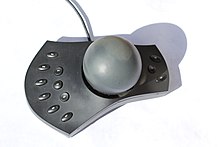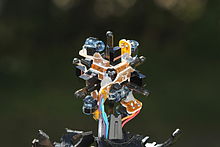3D mouse
A 3D mouse is an input device ( command transmitter ) for computers . In the most common use cases, it is used to move objects in a virtual 3D environment or to maneuver oneself through a virtual 3D landscape. Interactive applications are controlled by the input of a user. The following media are available for this: keyboard , (2D) mouse , joystick , space ball , data glove , voice input , image recognition and 3D mouse.
Device classes
Table-bound devices
A control element in the form of a ball or a puck is flexibly attached to a stationary base . Thrust and torsional forces that the user exerts on the control body are converted into input commands. Such a system has three translational and three rotational degrees of freedom. “3D mice or control balls use spring pressure to measure a static deflection for the position and angle of a ball that is enclosed in the user's hand. The deflection paths and angles are very small, so that the resolution of these devices is limited. Therefore control balls are mainly used for speed controls. "
A 3D mouse - also known as a space mouse - is suitable as an accessory to the normal mouse for two-handed operation. This form of interaction is felt to be particularly natural when the dominant hand acts relative to the less dominant hand. The two-handed interaction technique reduces the cognitive load on the user. With immersive visualization systems, the input media must not distract the user from the virtual 3D environment. It shouldn't restrict the user's movement either. Input devices shouldn't attract the user focus. These criteria are met by a 3D mouse.
Handheld devices
The user holds the input device in his hand and can move it freely around the room. Position and movement in the room are determined via sensors integrated in the device or external. If external sensors are used, one speaks of tracking .
history
The technology was from the 1970s at the German Center for Aerospace (DLR) from the Institute of Robotics and Mechatronics developed because one of the control of robots required input devices, all six degrees of freedom record (DoF, Eng. Degrees of Freedom). In the 1980s, at the same time in Europe (1982) and in the USA (1983) there were patents that described a control system in which the forces and moments were taken from the human hand by a hollow sphere. At the same time, at the DLR Institute for Robotics and Mechatronics, similar concepts for robot operation were being worked on under the name of Spacemouse .
In the course of the 1980s, however, this universal 6D input device established itself more as a navigation and positioning aid in virtual scenarios, in the field of 3D graphics and CAD applications. The development group at the DLR Institute obtained the international patent for this in 1985.
application areas
- Robotics: The handheld programming devices from KUKA Roboter n have been available with a 3D mouse since 1995. Here the user can intuitively move the robot in the desired direction by exerting force.
- 3D construction: Many 3D programs such as Pro / Engineer or AutoCAD support the use of 3D mice, so it is easier for the operator to navigate between the individual views or in the 3-dimensional space. The upper class of 3D mice has function keys that can be freely assigned. If you use a 3D mouse in the design, you can manipulate the model more intuitively, e.g. B. rotate and swivel. Although also called a mouse, they usually do not replace them, but are used in parallel with them, while switching between mouse and pen. When used for right-handers, the 3D mouse is on the left side of the keyboard so that it can be used at the same time as a mouse, pen, touchpad or touchscreen. Newer utility programs from 3Dconnexion also allow the display of a number pad with a back-delete key at the position of the mouse cursor on the screen . This means that the other pointing devices do not have to be put down in order to precisely change values or to enter them directly. This speeds up and simplifies the design process.
- Medicine: A 3D mouse can be used to simulate a surgical procedure, for example to be able to align the position of an implant in the patient's body in all three dimensions. A 3D mouse is also used as an input medium in the operation of congenital misalignments of the skull, for example for "hands-free correction of the position in the CAD system on a 2D monitor".
- Architecture: In computer augmented reality systems as used in architecture, the user's hand is normally free and can remain without any function for computer control, but it is often included to operate a 3D mouse.
- Home users: The price reduction of the technology (as of 2008: around 50 €) has made it possible to use 3D mice in private households to control games or to navigate in Google Earth .
Provider and versions
SpaceController, Spacemouse
The control element, which is attached to a base, can be pulled, pushed, tilted and rotated a few millimeters in all directions. After letting go, it jumps back to its starting position like a joystick . The six components (translation and rotation) are measured using friction-free and wear - free opto-electronic sensors . Several buttons attached to the base can be individually assigned by application programs.
Web links
- DLR SpaceMouse at the Institute for Robotics and Mechatronics of the German Aerospace Center (English)
Individual evidence
- ↑ D. Müller: Application Framework for the Development of Interactive Applications with Multi-Sensory User Interfaces - Approaches to a Prototype Realization of Computer Systems for Production. (PDF) (No longer available online.) April 1993, p. 10 , archived from the original on December 8, 2015 ; accessed on November 29, 2015 . Info: The archive link was inserted automatically and has not yet been checked. Please check the original and archive link according to the instructions and then remove this notice.
- ^ Heinrich Hussmann, Albrecht Schmidt: Guidelines Input Devices. (PDF) In: Lecture Human-Machine-Interaction. Ludwig Maximilians University Munich, 2004, p. 40 , accessed on November 29, 2015 .
- ^ Peter A. Henning: Pocket Book Multimedia. Hanser 2007. p. 226. ISBN 3-446-40971-8 . Online at Google Books.
- ↑ Thomas Klement, Matthias Hemmje: A configurable, constraint-based camera control for 3D visualization tools . (PDF) In: GMD study. Fernuniversität Hagen, p. 34 f , accessed on November 29, 2015 .
- ↑ Felix Ritter: Interactive assembly of 3D models to support spatial understanding. (PDF) In: Diploma thesis at the Otto von Guericke University Magdeburg. May 1999, p. 112 f , accessed on November 29, 2015 .
- ↑ Juri Engel, Jürgen Döllner: Immersive visualization of virtual 3D city models and their use in urban planning. (PDF) In: DGPF conference volume 21 / 2012. 2012, p. 5 f , accessed on November 29, 2015 .
- ^ Roland Schmitz: Compendium media informatics. Volume 2: Media Practice. Springer 2007. p. 94. ISBN 3-540-36629-6 . Online at Google Books.
- ↑ The DLR Space Mouse (1981 to 1993). DLR Robotics and Mechatronics Center, accessed on November 29, 2015 .
- ↑ André Stork: Efficient 3D interaction and visualization techniques for user-centered modeling systems. (PDF) In: Dissertation at the University of Darmstadt. Department of Computer Science at the Technical University of Darmstadt, August 2000, accessed on November 29, 2015 .
- ↑ . M. Shcherbinsky, GJ Lexow, Th S. Rau, B. Preim O. Majdani: computer aided planning Bonebridge ¨ operations. (PDF) Otto von Guericke University Magdeburg, 2015, accessed on November 29, 2015 .
- ↑ R. Stelzer, A. Koßler, M. Funke, U. Eckelt, M. Schneider: Virtual segmentation and fragment positioning for planning navigation-supported surgical interventions in reconstructive surgery. (PDF) (No longer available online.) TU Dresden, November 9, 2005, archived from the original on March 4, 2016 ; accessed on November 29, 2015 .
- ↑ Ingrid Rügge: hands-free or hand-controlled? Current trends in the design of human-computer interaction. (PDF) University of Bremen, Technologiezentrum Informatik, accessed on November 29, 2015 (Augmented Reality section).


